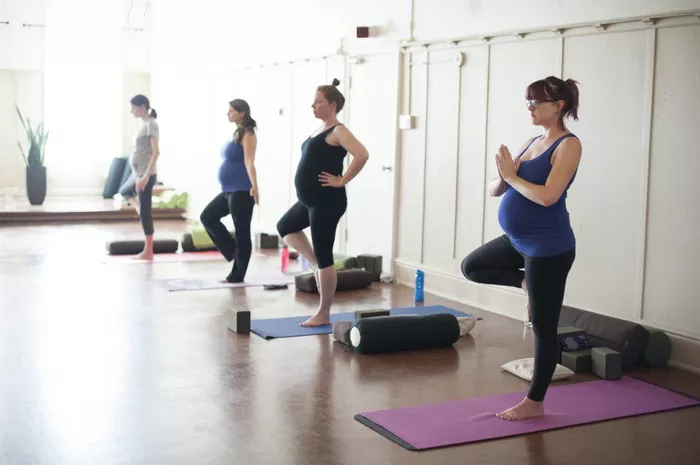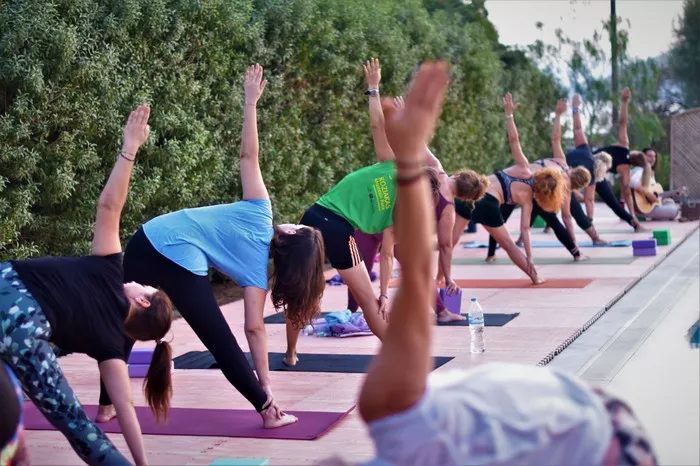Pregnancy is a time of profound transformation, and for those with some experience in yoga, intermediate prenatal yoga offers a more challenging and enriching way to connect with their bodies and the growing life within. This level of prenatal yoga builds upon the foundational knowledge and skills, providing a comprehensive approach to physical conditioning, mental relaxation, and emotional well-being. It is designed to meet the specific needs of pregnant women who have already established a basic yoga practice and are ready to explore deeper postures and techniques. In this article, we will explore the various aspects of intermediate prenatal yoga, including its unique benefits, key postures, breathing methods, and considerations for a safe and fulfilling practice.
The Advantages of Intermediate Prenatal Yoga
Enhanced Physical Conditioning
Intermediate prenatal yoga takes the physical benefits of basic prenatal yoga to the next level. It focuses on strengthening the core muscles more intensively, which is crucial for supporting the growing uterus and maintaining proper posture. Through postures like the modified side plank, the abdominal muscles, obliques, and pelvic floor muscles are engaged in a more challenging way. This increased core strength not only helps in reducing back pain but also prepares the body for the rigors of childbirth. Additionally, intermediate yoga helps in improving flexibility further, especially in the hips and spine. Poses such as the pigeon pose with a deeper stretch and the seated forward bend with a more pronounced elongation of the spine allow for greater freedom of movement and can relieve the tension that builds up in these areas as the pregnancy progresses.
Mental and Emotional Resilience
As the pregnancy advances, hormonal changes and the anticipation of childbirth can bring about increased stress and anxiety. Intermediate prenatal yoga provides a powerful antidote. The more complex postures and sequences require a heightened level of concentration and focus. This mental engagement helps in diverting the mind from pregnancy-related concerns and promotes a sense of calm and centeredness. The practice also encourages self-awareness and self-acceptance. As women attempt and master new postures, they build confidence in their bodies’ abilities, which in turn boosts their overall self-esteem. This positive mental state can have a profound impact on how they experience the remainder of their pregnancy and approach childbirth.
Preparation for Labor and Delivery
The specific postures and breathing techniques in intermediate prenatal yoga are tailored to better prepare the body and mind for labor. For example, the use of deep, controlled breaths during challenging postures mimics the breathing patterns that will be essential during contractions. Poses that open up the pelvis, such as the wide-legged squat with a deeper descent, can help in increasing the flexibility of the pelvic joints and creating more space for the baby to pass through during birth. The practice also helps in building endurance, as longer and more intense sequences are incorporated, enabling the mother to sustain the physical and mental effort required during labor.
Key Intermediate Prenatal Yoga Postures
The Modified Side Plank
Beginning in a plank position, the mother then shifts her weight onto one hand and the outer edge of the same-side foot. The other leg is stacked on top, and the body forms a diagonal line. This pose challenges the core muscles, especially the obliques and the supporting muscles of the hips. It helps in strengthening the sides of the abdomen, which is beneficial for maintaining balance and stability as the body changes during pregnancy. The modified side plank also stretches the intercostal muscles, improving breathing capacity.
The Deep Pigeon Pose
From a downward-facing dog position, the mother brings one knee forward and places it behind the wrist of the same side, with the shin parallel to the front of the mat. The other leg is extended straight back. She then slowly lowers her hips towards the floor, feeling a deep stretch in the front of the hip of the bent leg and along the inner thigh. This pose is excellent for opening up the hips, which is crucial for a more comfortable pregnancy and easier childbirth. It also helps in releasing tension in the lower back and can improve circulation in the pelvic area.
The Seated Spinal Twist (with Modifications)
Sitting on the mat with legs extended, the mother bends one knee and places the foot on the outside of the opposite thigh. She then twists her torso towards the bent knee, using the opposite elbow to gently press against the knee for a deeper twist. During pregnancy, it is important to keep the twist gentle and avoid compressing the abdomen. This modified spinal twist helps in maintaining spinal flexibility, massaging the internal organs, and relieving back pain. It also promotes digestion, which can sometimes be sluggish during pregnancy.
The Inverted Legs-up-the-Wall Pose
Sitting sideways next to a wall, the mother slowly lowers her back onto the floor and swings her legs up the wall until they are straight and perpendicular to the floor. The buttocks are close to the wall, and the arms can be relaxed at the sides or placed on the abdomen. This pose is a gentle inversion that helps in reducing swelling in the legs and feet, which is common during pregnancy. It also relieves pressure on the lower back and can have a calming effect on the nervous system.
Breathing Techniques in Intermediate Prenatal Yoga
Ujjayi Breathing with Extended Exhalations
Similar to the basic Ujjayi breathing, the mother inhales and exhales through the nose, creating a soft, ocean-like sound in the back of the throat. However, in intermediate prenatal yoga, the focus is on making the exhalations longer and more controlled. This extended exhalation helps in activating the parasympathetic nervous system, promoting relaxation and reducing stress. It also aids in better oxygen exchange, ensuring that both the mother and the fetus receive an adequate supply of oxygen.
Alternate Nostril Breathing with Pause
Beginning with a comfortable seated position, the mother uses her right thumb to close the right nostril and inhales deeply through the left nostril. She then closes the left nostril with the ring finger and exhales through the right nostril. After a brief pause, she inhales through the right nostril, closes it, and exhales through the left. This cycle is repeated several times. The addition of a pause between inhalations and exhalations helps in deepening the breath and enhancing concentration. It balances the energy in the body and can have a soothing effect on the mind, especially during times of heightened stress or anxiety.
Safety Considerations for Intermediate Prenatal Yoga
Progression Based on Individual Abilities
Each pregnant woman’s body is unique, and it is essential to progress in intermediate prenatal yoga at a pace that is comfortable and safe. What may be an appropriate level of challenge for one may be too strenuous for another. The mother should always listen to her body and avoid pushing herself into postures that cause pain or discomfort. If a particular pose feels too difficult, it can be modified or skipped altogether.
Avoiding Overexertion and Overstretching
While intermediate prenatal yoga does involve more challenging postures, it is crucial to avoid overexertion. Pregnant women should not hold their breath during postures, as this can increase intra-abdominal pressure, which may be harmful to the fetus. Additionally, overstretching, especially in the ligaments that are already loosening due to pregnancy hormones, can lead to injury. The focus should be on maintaining a balance between strength and flexibility, with an emphasis on proper form and technique.
Trimester-Specific Modifications
As the pregnancy progresses through different trimesters, certain modifications need to be made. In the second trimester, when the belly starts to grow more noticeably, poses that involve lying flat on the back should be avoided or modified. For example, in the supine leg lifts, the mother can place a bolster or folded blanket under her hips to elevate them slightly and reduce the pressure on the vena cava. In the third trimester, deep twists and forward bends may need to be adjusted to accommodate the larger belly and the changes in the center of gravity.
Instructor Guidance and Supervision
It is highly recommended that pregnant women practicing intermediate prenatal yoga have the guidance and supervision of a qualified instructor. An experienced instructor can provide personalized modifications, ensure correct form and technique, and offer support and encouragement. They can also monitor the mother’s progress and make adjustments to the practice as needed, based on any changes in the mother’s health or the progress of the pregnancy.
The Role of Intermediate Prenatal Yoga in Building Community
Group Classes and Shared Experiences
Attending intermediate prenatal yoga group classes allows pregnant women to connect with others who are at a similar stage of their pregnancy journey. Sharing the challenges and joys of practicing more advanced postures can create a sense of camaraderie. Women can support each other, offer tips and advice, and build lasting friendships. The group environment also provides an opportunity for emotional sharing, as they discuss their pregnancy-related concerns and experiences, which can be both therapeutic and empowering.
Online Communities and Forums
In addition to in-person classes, online communities and forums dedicated to intermediate prenatal yoga are a valuable resource. Here, women can ask questions, share their progress, and get feedback from others. They can also access additional resources such as video tutorials, articles, and blogs related to intermediate prenatal yoga. These online platforms expand the reach of the community, allowing women from different locations to connect and learn from each other.
Postnatal Continuity
The relationships and knowledge gained from intermediate prenatal yoga can often extend into the postnatal period. Many women who practice together during pregnancy continue to support each other after childbirth. They may attend postnatal yoga classes together, share parenting tips, and help each other navigate the new challenges of motherhood. This continuity provides a strong support network that can be beneficial for both the physical and mental well-being of new mothers.
Incorporating Intermediate Prenatal Yoga into a Daily Routine
Morning Energizing Practice
A short intermediate prenatal yoga session in the morning can be a great way to start the day. It can include a few rounds of sun salutations with modifications, followed by some standing postures like the tree pose and the warrior series. These postures help in waking up the body, improving balance and focus, and setting a positive tone for the day ahead. The breathing techniques practiced during this morning session can also help in increasing energy levels and reducing morning grogginess.
Afternoon Stress Relief
In the afternoon, when stress levels may be higher, a more relaxing intermediate prenatal yoga practice can be beneficial. Poses such as the seated forward bend, the reclining bound angle pose, and the legs-up-the-wall pose can be incorporated. These postures help in relieving tension in the back, hips, and legs, and the accompanying breathing exercises can calm the mind and reduce stress. A 20-30 minute session in the afternoon can provide a much-needed break and rejuvenation.
Evening Relaxation and Bonding
An evening intermediate prenatal yoga practice can focus on relaxation and connecting with the baby. Gentle twists and side stretches can be combined with deep relaxation poses like the corpse pose. The mother can also place her hands on her belly and practice visualization and positive affirmations during the relaxation, strengthening the bond with the unborn child. This evening session helps in winding down, preparing the body and mind for a restful sleep, and promoting a sense of peace and well-being.
Conclusion
Intermediate prenatal yoga offers a wealth of benefits for pregnant women with some prior yoga experience. It not only enhances physical strength and flexibility but also promotes mental and emotional well-being, prepares for labor and delivery, and fosters a sense of community. By following safety guidelines, incorporating key postures and breathing techniques, and making it a part of a daily routine, pregnant women can fully embrace the transformative power of intermediate prenatal yoga and have a more fulfilling pregnancy journey.
Related topics:


























